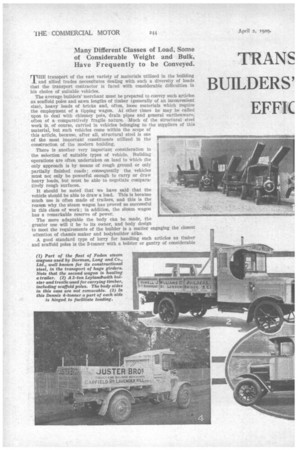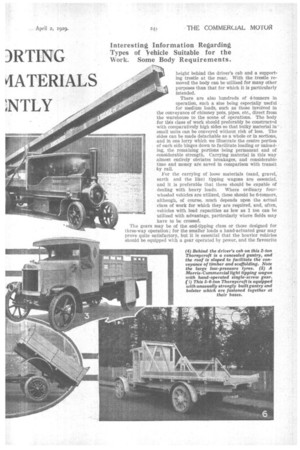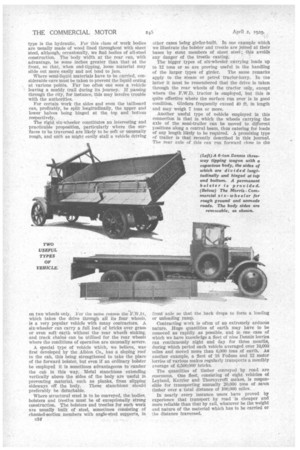TRANS JRTING BUILDERS' vIATERIALS EFFIC NTLY
Page 54

Page 55

Page 56

If you've noticed an error in this article please click here to report it so we can fix it.
TE transport of the vast variety of materials utilized in the building and allied trades necessitates dealing with such a diversity of loads that the transport contractor is faced with considerable difficulties in his choice of suitable vehicles.
The average builders' merchant must be prepared to convey such articles as scaffold poles and sawn lengths of timber (generally of an inconvenient size), heavy loads of bricks and, often, loose materials which require the employment of a tipping wagon. At other times he may be called upon to deal with chimney pots, drain pipes and general earthenware, often of a comparatively fragile nature. Much of the structural steel work is, of course, carried in vehicles belonging to the suppliers of this material, but such vehicles come within the scope of this article, because, after all, structural steel is one of the most important constituents utilized in the construction of the modern building.
There is another very important consideration in the selection of suitable types of vehicle. Building operations are often undertaken on land to which the only approach is by means of rough ground or only partially finished roads ; consequently the vehicles must not only be powerful enough to carry or draw heavy loads, but must be able to negotiate comparatively rough surfaces. It should be noted that we have said that the vehicle should be able to draw a load. This is because much use is often made of trailers, and this is the reason why the steam wagon has proved so successful in this class of work; in addition, the steam wagon has a remarkable reserve of power. The more adaptable the body can be made, the greater use will it be to its owner, and body design to meet the requirements of the builder is a matter engaging attention of chassis maker and bodybuilder alike.
A good standard type of lorry for handling such articles as timber and scaffold poles is the 3-tonner with a bolster or gantry of considerable
the closest height behind the driver's cab and a supporting trestle at the rear. With the trestle removed the body can be utilized for many other purposes than that for which it is particularly intended.
There are also hundreds of 4-tanners in operation, such a size being especially useful for medium loads, such as those involved in the conveyance of chimney pots, pipes, etc., direct from the warehouse to the scene of operations. The body for this class of work should preferably be constructod with comparatively high sides so that bulky material in small units can be conveyed without risk of loss. The sides can be made detachable as a whole or in sections, and in one lorry which we illustrate the centre portion of each side hinges down to facilitate loading or unloading, the remaining portions being permanent and of considerable strength. Carrying material in this way almost entirely obviates breakages, and considerable time and money are saved in comparison with transit by rail.
For the carrying of loose materials (sand, gravel, earth and the like) tipping wagons are essential, and it is preferable that these should be capable of
dealing with heavy loads. Where ordinary fourwheeled vehicles are utilized, these should be 6-tonners, although, of course, much depends upon the actual class of work for which they are required, and, often, vehicles with load capacities as low as 1 ton can be utilized with advantage, particularly where fields may have to be crossed.
The gears may be of the end-tipping class or those designed for three-way operation ; for the smaller loads a hand-actuated gear may prove quite satisfactory, but it is essential that the heavier vehicles should be equipped with a gear operated by power, and the favourite
type is the hydraulic. For this class of work bodies are usually made of wood lined throughout with sheet steel, although, occasionally, we find .bodies of all-steel construction. The 'body width at the rear can, with advantage, be some inches greater than that at the front, so that, when end-tipping, loose material may slide out more easily and not tend to jam.
Where 'semi-liquid materials have to be carried, considerable care must be taken to prevent the liquid oozing at various points. Far too often one sees a vehicle leaving a muddy trail during its journey. If passing through the city, for instance, this may involve trouble with the authorities.
For certain work the sides and even the tailboard can, profitably, be split longitudinally, the upper and lower halves being hinged at the top and bottom respectively.
The rigid six-wheeler constitutes an interesting and practicable proposition, particularly where the surfaces to'be traversed are likely to be soft or unusually rough, and such as might easily stall a vehicle driving
on two wheels only. For the same reason the.'F.W.D., which takes the drive through all its four wheels, is a very popular vehicle with many contractors; A six-wheeler can carry a full load of bricks over grass or even soft earth without the rear wheeTh sinking, and track chains can be utilized for the rear wheels where the conditions of operation are unusually severe.
A special type of vehicle which, we believe, was first developed by the Albion Co., has a sloping roof to the cab, this being strengthened to take the place of the forward bolster, but even if an ordinary bolster be employed it is sometimes advantageous to camber the cab in this way. Metal stanchions extending vertically above the sides of the body are useful in preventing material, such as planks, from slipping sideways. off the body. These stanchions should preferably be detachable.
Where structural steel is to be conveyed, the bodies, bolsters and trestles must be of exceptionally strong construction. The bolsters and trestles for such work are usually built of steel, sometimes consisting of channel-section ,members with angle-steel supports, in c34' other cases being girder-built. In one example which we illustrate the bolster and trestle are joined at their bases by stout members of sheet steel; this avoids any danger of the trestle canting.
The bigger types of six-wheeler carrying loads up to 12 tons or so are proving useful in the handling of the larger types of girder. The same remarks apply to the steam or petrol tractor-lorry. In the latter it must be remembered that the drive is taken through the rear wheels of the tractor only, except where the F.W.D, tractor is employed, but this is quite effective where the surface run over is in good condition. Girders frequently exceed 40 ft. in length and may weigh 7 tons or more.
Another useful type of vehicle employed in this connection is that in which the wheels carrying the axle of the semi-trailer can be moved to different positions along a central beam, thus catering for loads of any length likely to be required: A promising type of trailer is that recently described in this journal. The rear axle of this can run forward close to the front axle so that the back drops to form a loading or unloading ramp. .
Contracting wark is often of an extremely arduous nature. Huge quantities of earth may have to be removed as rapidly as possible, and in one case of which we have knowledge a fleet of nine Dennis lorries ran continuously night and day for three months, during which period each vehicle averaged over 10,000 miles and moved More than 0,000 tons of earth. As another example, a fleet of 18 Fotlens and 12 motor lorries of various makes regularly transports a monthly average of 0,500,000' bricks.
The quantities of timber conveyed by road are enormous. One fleet, consisting of eight vehicles of Leyland, Karrier and Thornycroft makes, is responsible for transporting annually 20,000 tons of sawn timber over a total distance of 100,000 miles, In nearly every instance users have proved by experience that transport by road is cheaper and more reliable than that by rail, whatever be the weight and nature of the material which has to be carried or the distance traversed..












































































































